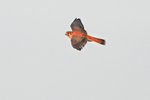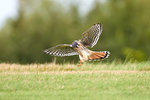

, juvenile bird..jpg)
The Falcons, of the Genus Falco, are raptors - birds of prey. There are 40 species worldwide. They are exceptionally fast flyers, able to catch their prey on the wing. And these wings are long and tapered, appearing to end with a point. Most other raptors’ wings have a distinctive spread of feathers. And most falcons have distinctive identifying feather patterns on their heads. They also have a strong sexual size difference, with females larger, and they have great distance vision, as do all raptors. Falcons are migratory, following migrating flocks of prey birds.
We have three Falcons in our home territory. They are easily distinguished by size, color, typical territory, and behavior.
The smallest of our local falcons is the American Kestrel. It formerly had the common name Sparrowhawk, but years ago this was dropped in favor of the European common name, Kestrel. These are small birds, only 9 inches long (smaller than a Robin), with sexes about equal in size. They are found in open areas where they are often seen on perches and utility lines.
Kestrels are beautiful birds. The male has a rufous back, a slate-blue crown and wings, and two vertical black slashes on his face. The female is duller rufous overall, and has black facial slashes. Back feathers of both sexes have black barring. Kestrels often hunt by hovering, still as a hummingbird above grasslands, then diving to make a kill.
Kestrels have a strong bond with their mates and establish permanent year-round nesting territories. They nest in cavities and respond well to human-created nest boxes. Such boxes are in place on several of our Thurston County prairie natural areas. A pair of Kestrels has a home territory in the lower Nisqually Valley, where they are often seen on wires along secondary roads south of I-5.
The second falcon species found in Thurston County is the Merlin. These birds are also small (only 11 inches, with females larger), and its old-fashioned name was pigeon hawk because its size and flight were seen as pigeon-like (and pigeons were frequent prey). The Merlin is a very fast-flying falcon, and its most common source of food are the flocks of shorebirds (such as sandpipers) that migrate along our coast. It pursues its prey by fast horizontal flight, taking the shorebird flock by surprise and putting it into flight. The Merlin will zero in on a single bird and pursue it until, eventually, the target bird tires and is taken for dinner.
Merlins have uniform dark backs and striped breasts, with faint head marks; sexes are similar in coloration. Here in the Pacific Northwest, our local birds appear very dark. They are usually seen singly, perched on shorelines, or on an edge branch overlooking an open area. If you see a flock of shorebirds suddenly burst into flight, look closely, and you may well see the hunting Merlin that caused all the ruckus.
The royalty of all the falcons is the Peregrine Falcon. It is found on all continents, excepting Antarctica, and its name “peregrine,” derives from the Greek word for stranger or wanderer. As a widespread species, regional subspecies have dramatically different appearances, including here. Our subspecies, called “Peale’s,” is larger than most, the size of a large crow with long wings. It is uniformly gray above with a whitish chest with black barring. Its head is also gray with a single wide stripe. In good light, you may be able to see yellow feet and cere (the knob behind its black beak). Sexes are alike, and the female is about 10% larger. Immatures appear more brownish with streaking on the chest.
Many Peale’s Peregrines are non-migratory, spending their lives in an established feeding and nesting territory. For a number of years, we had a breeding pair of peregrines using a crane in the Port of Olympia as a breeding platform. Urban nesting peregrines sometimes utilize graveled rooftops, nesting in a scraped area and feeding their young a steady diet of city pigeons. We are also visited by migratory peregrines that prey on our wintering duck flocks.
In its classic hunting pattern, the peregrine hunts flying high, scanning an area, and then swoops down (called stooping) at very high speeds to make its kill. Researchers have calculated a stooping peregrine’s flight at over 200 mph, making it the fastest of all animals.
For millennia, humans have taken young peregrines and their larger relative, the Gyrfalcon, to train as hunting birds. Often called a sport, falconry has an ancient past and is much associated with mythical lore. The Egyptians used the peregrine as a symbol of royal authority and power. Even today, in some areas training and hunting with these birds is restricted to the nobility.
George Walter is environmental program manager at the Nisqually Indian Tribe’s natural resources department; he also has a 40+ year interest in bird watching. He may be reached at george@theJOLTnews.com
Photos for this column are provided by Liam Hutcheson, a 15-year-old Olympia area birder and avid photographer.
Comments
No comments on this item Please log in to comment by clicking here